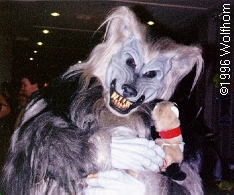

Visitors to Haunted Verdun Manor are often mere inches away from our werewolves. Because of this, it's very important that they stand up to close scrutiny and still look real. Unlike vampires - which require only a good set of fangs and little if any makeup - a werewolf requires extensive work to pass this realism test. While not all of our werewolf characters involve this much effort, all those that will interact closely with the public are played by a single actor in a custom-fitted costume or "fursuit." Usually, the actor has built the fursuit himself or herself, under our direction and advice. Starting from scratch, the process takes six weeks or more. This web page just touches on how we make a werewolf. Take note that it may take a few minutes to load this page; there are quite a few pictures. We'll use Boris (made & worn by Lance Pope) as an example.
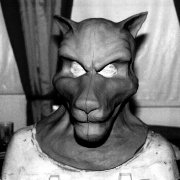 |
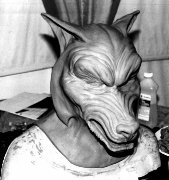 |
First, we begin with a lifecast of the actor's full head and shoulders. We then sculpt the werewolf's head on top of the lifecast, beginning with a rough shape (on the left) and ending with the very detailed final sculpture (on the right). A mold is then made of the finished sculpture, and a core mold is made for the interior of the head. These molds are used to make a foam latex skin that will be the "skin" of the werewolf's head. Foam latex is used for greater flexibility, but it limits the skin's lifetime to three or four years.
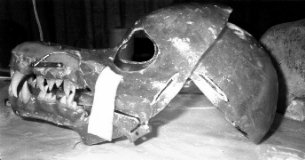 |
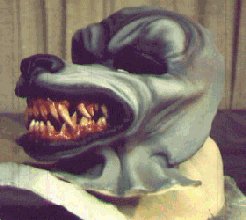 |
The next step is making the underskull for the head. It's made out of fiberglass and serves to hold the shape of the skin and the teeth (sculpted and molded separately, and made from dental acrylic). It also lets the jaw move realistically, and allows for other motions. This underskull (Boris') on the left has a snarl mechanism built into it in addition to the jaw hinge. The foam skin has been painted and fitted onto the underskull in the right picture. The back of the head and ears are attached separately, then fur is applied to the back and sides of the head, with individual hairs set by hand to blend the face into the fur. Other werewolves we've made have fully furred faces.
 |
 |
The hindpaws (feet) and forepaws (hands) are sculpted over lifecasts and molds are made; unlike the head, they are then slush cast with latex. The hindpaws are made particularly thick to last longer. Mold lines must be ground off of all four paws. Claws are made by hand and attached after the paws are painted. Some of our werewolves are equipped with arm and leg extensions.
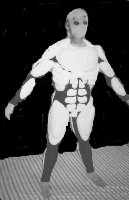 |
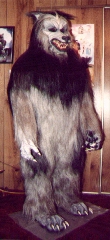 |
Now work proceeds to the fursuit itself. First, a cotton/lycra unitard is put on a form that's been built up to match the actor. Then, the muscles are built up as needed out of foam and attached to the unitard. The suit is furred in different colors and lengths as needed, the fur is trimmed and detail patterns are airbrushed in. Sometimes, the fur is kept as a separate second suit, worn over the muscle suit, if the werewolf is going to be used for film work. Having two separate suits looks more realistic, but adds a lot of time to make the suit and keep it repaired. FYI, we use National Hair Technologies fur for our suits. It's totally artificial but looks and feels like real animal fur.
To become the werewolf, the actor puts on an undersuit, usually of cotton/lycra, and puts on a cool vest on top of that. Some of us like to wear more solid padding as well - football girdles, motocross or hockey pads, shin guards, and even elbow/knee pads, depending on what we'll be doing while "in the fur." Makeup is applied around the eyes to make it easier to blend in later. The fursuit is put on next, followed by the paws, and finally the head is added. The makeup around the eyes is blended into the eyes of the head, and the werewolf is ready to prowl the halls of Verdun Manor …